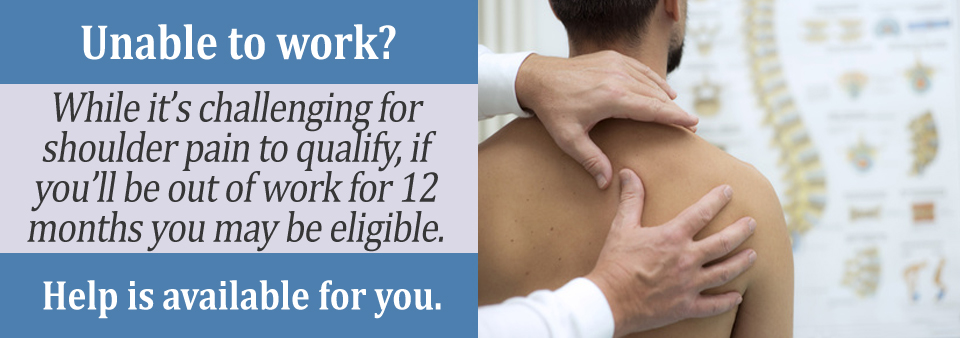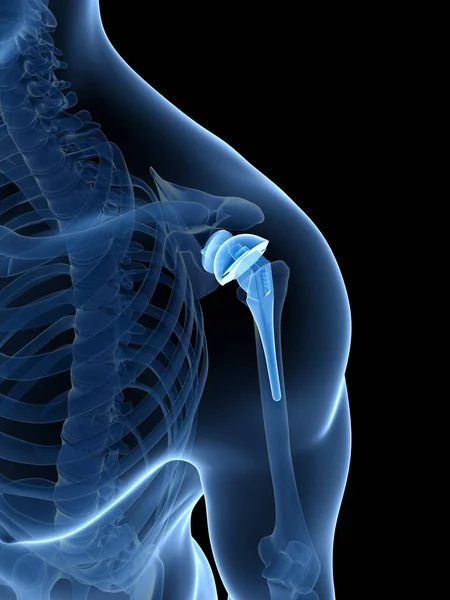Shoulder pain, while often self-limiting, affects up to two-thirds of all Americans at some point during their lives. While most people think that the shoulder is one joint, it is actually made up of several joints, tendons, and muscles. Because we use our arms for so many things, from washing our hair to eating, it is subject to injuries or overuse.
Most shoulder problems are minor and therefore would not qualify for Social Security disability. However, in some rare conditions, a shoulder injury can keep a person out of work for good. Although anyone can qualify for Social Security Disability Insurance (SSDI) benefits, those who are older or who have more labor-intensive jobs are more likely to be eligible for disability benefits through the Social Security Administration (SSA).
Musculoskeletal Disability
A musculoskeletal disability or disorder is a condition that is either acquired or congenital and might involve the major joints or bones; muscles, tendons, ligaments, and other soft tissues. Musculoskeletal disabilities or conditions are usually distinguished by limitations in dexterity and mobility, as well as pain that is oftentimes persistent, that comes together to interfere with and inhibit people’s ability to participate in society and daily activities such as work. Experiencing pain in the musculoskeletal structures is the most common type of non-Cancer pain. Given that they can range from short-lived conditions that arise suddenly (e.g., sprains, strains, fractures, and other pain that causes inhibitions in proper function) to chronic conditions that are longer-term (e.g., osteoarthritis, chronic primary lower back pain, etc.), musculoskeletal disabilities (conditions) are pertinent throughout all stages of life. In terms of contributing to the need for rehabilitation, conditions involving the musculoskeletal structure (i.e., a musculoskeletal disability) are the highest contributor.
Let’s take a closer look at the conditions that are considered to be musculoskeletal disabilities (a.k.a., musculoskeletal conditions). Conditions are considered to be musculoskeletal conditions if they affect: 
- Bones (e.g., osteopenia and associated “fragility fractures,” osteoporosis, traumatic fractures);
- Joints (e.g., rheumatoid arthritis, osteoarthritis, psoriatic arthritis, spondyloarthritis, gout);
- Muscles (e.g., sarcopenia);
- Multiple Body Areas or Systems (e.g., inflammatory diseases like vasculitis and connective tissue diseases that have musculoskeletal manifestations (e.g., systemic lupus erythematosus, amputation due to trauma or disease, etc.), widespread pain conditions (e.g., fibromyalgia) and regional pain (e.g., neck and back pain) conditions).
According to research conducted by professionals in the osteopathic medicine field, shoulder disorders make up the third largest group of patients with musculoskeletal disorders observed in primary care. Lower back pain and neck disorders account for the first and second largest groups of patients with musculoskeletal conditions (i.e., a musculoskeletal disability).
Disorders affecting the musculoskeletal system that the Social Security Administration (SSA) classifies as a musculoskeletal disability(s) are listed in Section 1.00–Musculoskeletal Disorders in their Blue Book.
Shoulder Disability
A shoulder disability is a condition or injury that causes an individual to be unable to perform the gross  and fine movements that are necessary in everyday life—i.e., those that are required to carry out daily tasks. For a shoulder condition to be considered a shoulder disability by the SSA, your shoulder condition must cause you pain that is severe enough that it prohibits you from being able to work for at least the next 12 months.
and fine movements that are necessary in everyday life—i.e., those that are required to carry out daily tasks. For a shoulder condition to be considered a shoulder disability by the SSA, your shoulder condition must cause you pain that is severe enough that it prohibits you from being able to work for at least the next 12 months.
Shoulder pain is one of the most common regional pain syndromes that, according to population surveys published by the National Institutes of Health (NIH), impacts approximately 18 percent to 26 percent of adults. Generally speaking, the prevalence of shoulder pain tends to be higher among people who are over the age of 50. This is especially true for those who have physically active occupations.
The most common types of shoulder problems are outlined in the following list:
- Shoulder Strains and Shoulder Sprains
- Shoulder Separations
- Shoulder Dislocations
- Tendinitis of the Shoulder
- Bursitis of the Shoulder
- Torn Rotator Cuffs
- Frozen Shoulders
- Fractures of the Shoulder (i.e., breaking a bone(s) within the shoulder’s structure)
- Arthritis of the Shoulder
If you have one of these shoulder conditions and/or injuries, and it has gotten severe enough to prevent you from being able to work for at least the next 12 months, you may be able to qualify for disability benefits for your shoulder disability through the Social Security Administration (SSA).
What Types of Shoulder Problems Might Qualify for a Disability Award?
A number of shoulder conditions can affect a person’s ability to perform their day-to-day life functions. From arthritis of the shoulder and torn ligaments to “frozen shoulders,” those who have experienced shoulder difficulty know just how excruciating and debilitating it can be. Despite the discomfort, most shoulder injuries are self-limiting and heal relatively quickly. As a result, very few shoulder conditions would qualify an individual for disability benefits.
However, there are some instances where a shoulder condition might be severe enough to warrant disability payments. For example, if you can prove that your shoulder injury leaves you unable to perform fine and gross movements of your hands and arms, you might qualify for disability under section 1.02 of the Blue Book.

Using the Blue Book to Qualify
The Blue Book is the manual used by the SSA to determine which conditions automatically qualify  for disability benefits. Section 1.02, which describes major dysfunctions of a joint, states that if your shoulder injury leaves you unable to prepare a simple meal or feed oneself or if it causes you to be unable to take care of personal hygiene, you might be eligible for Social Security disability benefits.
for disability benefits. Section 1.02, which describes major dysfunctions of a joint, states that if your shoulder injury leaves you unable to prepare a simple meal or feed oneself or if it causes you to be unable to take care of personal hygiene, you might be eligible for Social Security disability benefits.
The vast majority of individuals will not meet a Blue Book listing for their shoulder injury. However, they may still be too injured to work. These individuals might qualify for SSDI benefits through a medical-vocational allowance. When evaluating individuals for a medical-vocational allowance, the SSA considers an applicant’s age, their previous work experience, and their educational level. Individuals who are less-educated, older, and with fewer skills are more likely to qualify for disability benefits for a shoulder injury.
A medical-vocational allowance would be more relevant for someone who must use their arms and hands frequently for work. For example, a long-term rotator cuff injury or severe osteoarthritis of the shoulder would make working as a mechanic or a carpenter particularly difficult. Therefore, a 60-year-old hair stylist with only a high school diploma would be more likely to qualify for SSDI than a 45-year-old secretary.
Should I Reach Out to a Social Security Attorney for Assistance?
Qualifying for SSDI with a shoulder injury is very challenging, although not impossible. The best way to win your case is to keep excellent medical records of your condition, as well as any difficulty that you might have at your job. In addition to helping you prepare your application, a qualified Social Security attorney can help you to determine what medical records you might still want to gather to strengthen your case.
Additional Resources
- Applying for Disability After a Shoulder Replacement
- Osteoarthritis and Disability
- Shoulder Replacement and Social Security Disability
- Shoulder Problems and SSDI
- Tips For Qualifying with a Musculoskeletal Disorder
- What Conditions Are Considered a Disability?
- What Spinal Disorders Qualify For Disability?